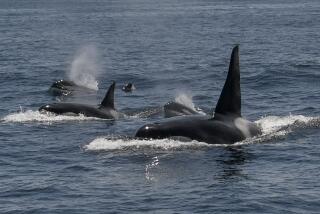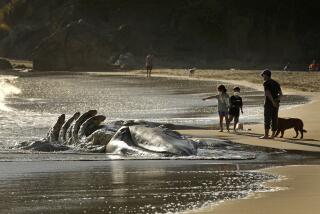Tongues Are Whales’ Key to Warmth While Eating
- Share via
John Heyning stands in the middle of a Vernon warehouse, surrounded by spinal columns suspended like giant mobiles from the high ceiling, whale skulls several Cadillacs long and bottles of formaldehyde cradling fin tissue. The formless space--a makeshift lab where Heyning performs most of his research--is crammed with marine mammals past and the instruments used to unravel their secrets.
Heyning’s recently completed studies on heat regulation in gray whales have changed the way scientists look at the aquatic mammal’s survival. And his findings could have significant implications for conservation of whales.
Heyning’s discovery: It’s all in the tongue.
The details of heat maintenance have long eluded marine biologists. While the blubber provides exterior insulation, no one had been able to conclude how whales endured severe cold while feeding, leaving their gigantic mouths exposed to arctic waters for up to 20 hours a day. Why this continued exposure to 30-degree seas did not dramatically affect their core body temperatures was unknown.
“Up till now, a major part [of the explanation] was missing,” said Heyning, curator of mammals for the Natural History Museum of Los Angeles County. “People calculated that a whale had enough heat to swim, but not enough to feed.”
Conventional wisdom identified blubber as a whale’s main heat trap. Heyning’s study was able to show that more heat can be lost through the blubber of a whale than through the tongue.
With the help of a live whale named J.J. found off the coast of Marina del Rey, Heyning and his colleague James G. Mead verified that whales’ tongues, more so than blubber, were used to control heat regulation. Their results were published recently in the journal Science.
*
In his previous work in New Zealand, Heyning examined how water currents affect whale feeding patterns. He came across small networks of arteries and veins in the tongue that were linked to temperature conservation.
These vessels, called countercurrent heat exchangers, had been found in other parts of the whale body; before Heyning’s studies, scientists had concentrated on the heat regulators in whale flukes and fins.
The discovery of the countercurrent heat exchangers in the tongue filled in the scientific blank. Just as startling as Heyning’s finding was the short amount of time in which he and Mead completed the research. Heyning was able to conclude the studies in just under a year.
“Under normal circumstances,” he said, “it would be impossible to get this kind of research done so quickly.” The effort would not have been complete, he says, if it had not been for J.J., a baleen whale stranded off Marina del Rey that Heyning helped rescue in January.
After the researchers brought their study back to the United States, they worked on two calves that washed up on the California shore. At the Vernon lab, they were able to tease out evidence of the countercurrent heat exchangers. But they needed a live specimen to test their theories.
“J.J. was a once-in-a-lifetime opportunity,” Heyning said. “It was the only way we could get active measurements.”
Once he had identified the heat exchangers from the two whale calves, Heyning measured J.J.’s heat responses in action. During a series of feedings at a tank in San Diego’s Sea World, the scientists measured the temperature of the whale’s tongue and skin.
The key finding was that little heat was transferred out of the tongue, suggesting that the tongue was recirculating warmth back to the body core through the devices Heyning and Mead had uncovered.
Sentiel Rommel, a researcher of marine mammal pathobiology at the Florida Department of Environmental Protection, calls the findings “incredibly exciting.”
Rommel has worked with Heyning on thermo-regulation and is now studying the anatomy of manatees. “The beauty of John’s work,” Rommel said, “is not only did he predict, but he verified.”
He explained that access to live specimens, such as J.J., is the ideal but rare situation and that dead subjects are hard to manage because of their extreme size. “It’s difficult to cut through a ton or two or three of fat and get to what you’re looking for,” Rommel said. “When you take apart a gray whale, even a small one, you have hundreds of pounds of innards. It’s hard to get away from it and get a reasonable picture.”
This difficulty involved in examining subjects has led to assumptions about whales based on estimates of smaller mammals--including humans. “Most of our picture of what goes on in the world is based on our own human experience,” Rommel said. “Traditionally people feel that if you’re swimming around in cold water you need insulation. This tradition of whales being big and fat to keep their warmth in water is just not valid. This is a convenient way for us to understand it.”
“People didn’t automatically look to the tongue because it is so vascular,” Heyning said. The same attributes that allow the tongue to remain flexible and porous make it an unlikely candidate for heat regulation.
But nevertheless, Heyning found it to be a key component.
The application of his conclusions should prove extremely valuable, particularly in the arena of conservation of these mammals. With more accurate information on their feeding and migration habits, conservationists can more accurately plan for their survival.
“This interpretation will allow us to better extrapolate measurements that we can’t usually get at with these guys,” Rommel said. Most importantly, the results should give new insights into the feeding and migration habits of the aquatic mammals.
Rommel calls the discovery “a beautiful application of physics.” Heyning puts it more modestly: “It’s all about plumbing and heating,” he says. “And we were finally able to figure out both.”
More to Read
Sign up for Essential California
The most important California stories and recommendations in your inbox every morning.
You may occasionally receive promotional content from the Los Angeles Times.










